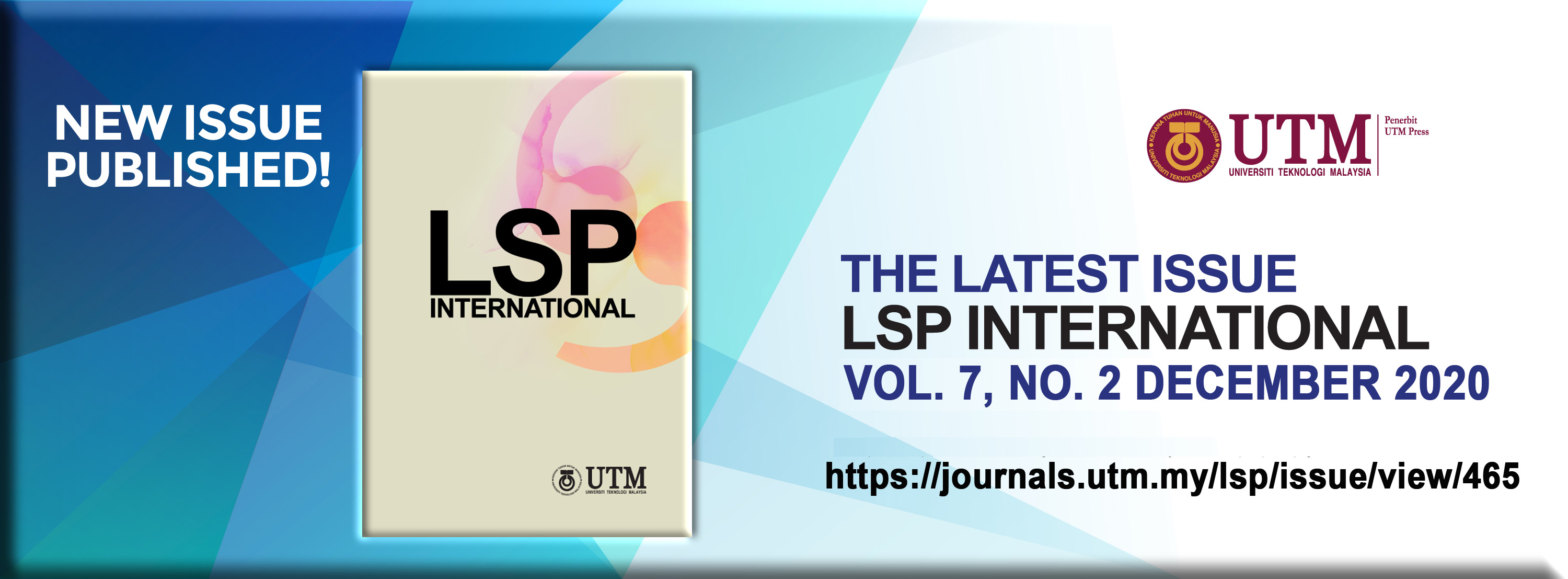Normalization Techniques For Translating Cultural - Specific Expressions
DOI:
https://doi.org/10.11113/lspi.v7.15264Abstract
For readability of audience in target culture (TC), cultural-specific expressions (CSEs) which have been embedded with specific characteristics, need specific techniques to transfer them into target language (TL). This study aims to identify normalization techniques (NTs) from domestication strategies to show that they are particularly necessary for CSE translation. Based on the previous studies of different scholars, the overlap between domestication and normalization is clarified, following by the clarification of the relation between normalization and the use of translator’s subjectivity, as well as the distinction between CSEs and universals for simple explanation on what normalization and CSE are. Last but not least, the overlapping NTs, classified from domestication strategies will be unified. Finally, illustration of normalization of CSEs, selected from Thai target text (TT) and its English source text (ST), The Da Vinci Code (DVC), a novel by Dan Brown, will give an overt explanation of how each NT is used to deal with CSEs in order to show relation between characteristics of CSEs and each NT. This will answer why NTs are necessary.
References
Al-Idhesat, T. A. S. (2016). The Translation of Cultural Elements from English into Arabic in Oliver Twist. (Master Degree), University of Malaya, Kuala Lumpur. Retrieved from http://studentsrepo.um.edu.my/id/eprint/6813
Baker, M. (1992). In Other Words: A Coursebook on Translation (1st ed.). London and New York: Routledge.
Baker, M. (1993). Corpus Linguistics and Translation Studies - Implications and Applications. In M. Baker, G. Francis, & E. Tognini-Bonelli (Eds.), Text and Technology: In Honour of John Sinclair (pp. 233-250). Philadelphia and Amsterdam: John Benjamins Publishing Company.
Baker, M. (1996). Corpus-based translation studies: The challenges that lie ahead. In H. Somers (Ed.), Terminology, LSP and Translation: Studies in Language Engineering, in Honour of Juan C. Sager (Vol. 18, pp. 175-186). Amsterdam and Philadelphia: John Benjamins Publishing Company.
Coles, R. (2012). Domesticating the Trauma of War in Translation. Libri & Liberi: časopis za istraživanje dječje književnosti i kulture, 1(1), 45-66.
Dabaghi, A., & Bagheri, M. (2012). The Issue of Translating Culture: A Literary Case in Focus. Theory and Practice in Language Studies, 2(1), 183-186. doi:10.4304/tpls.2.1.183-186
Giaber, J. M. (2015). Implications of Lexical Choices in Translating Novels as Literary Texts: The Case of A Farewell to Arms in Arabic trans-kom, 8(2), 415-445
Halliday, M. A. K. (1985). An Introduction to Functional Grammar. London: Edward Arnold.
Harvey, M. (2003). A Beginner's Course in Legal Translation: The Case of Culture-Bound Terms.
Marco, J. (2009). Normalization and the Translation of Phraseology in the COVALT Corpus. Meta, 54(4), 842-856. doi: https://doi.org/10.7202/038907ar
Melton, J. G. (2018, October 08, 2018). Wicca. Retrieved from https://www.britannica.com/topic/Wicca
Molina, L., & Albir, A. H. (2002). Translation Techniques Revisited: A Dynamic and Functionalist Approach. Meta, 47(4), 498-512. doi: https://doi.org/10.7202/008033ar
Mostafa, M. M. (2015). Translating Le Monde and El País English Business Loan Terms into Arabic: A Corpus-based Analysis. Journal of Language Teaching and Research, 6(1), 61-70. doi: http://dx.doi.org/10.17507/jltr.0601.07
Mussche, E., & Willems, K. (2010). Fred or farīd, bacon or bayḍun (‘egg’)? Proper Names and Cultural-specific Items in the Arabic Translation of Harry Potter. Meta, 55( 3), 474-498. doi: https://doi.org/10.7202/045066arCopiedAn
Newmark, P. (1988). A Textbook of Translation New York and London: Prentice-Hall International
Nida, E. A. (1964). Toward a Science of Translating: With Special Reference to Principles and Procedures Involved in Bible Translating. Leiden: E. J. Brill.
Olexová, K. (2009). Translation of Character Names in Children’s Literature: A Chronological View. (Master Diploma Thesis), Masaryk University.
Pedersen, J. (2005). How is culture rendered in subtitles? Paper presented at the MuTra 2005 – Challenges of Multidimensional Translation.
Pedersen, J. (2011). Subtitling Norms for Television: An Exploration Focussing on Extralinguistic Cultural References (Vol. 98). Amsterdam and Philadelphia: John Benjamins Publishing.
Prawiro, I. Y. (2018). Translation: When the Language, Culture and Herbs Are Mixed in the Same Bowl. Wacana Didaktika, 10(2), 22-30.
Shuttleworth, M., & Cowie, M. (1997). Dictionary of translation studies. London and New York: St. Jerome Pub.
Venuti, L. (1995). The Translator's Invisibility: A History of Translation (S. Bassnett & A. Lefevere Eds.). London and New York: Routledge.
Vinay, J.-P., & Darbelnet, J. (1995). Comparative Stylistics of French and English: A Methodology for Translation. Amsterdam/Philadelphia: John Benjamins Publishing Company.
Vinay, J.-P., & Darbelnet, J. (1995). Introduction. In J. C. Sager & M.-J. Hamel (Eds.), Comparative Stylistics of French and English: A Methodology for Translation (Vol. 11, pp. 30-41). Amsterdam/Philadelphia: John Benjamins Publishing Company.
W, O. V. V., & Asmarani, R. (2016). The Translation Procedures of Cultural Expressions Applied in “A Game of Thrones”. LITE, 12(2), 199-218.
Wang, F. (2014). An Approach to Domestication and Foreignization from the Angle of Cultural Factors Translation. Theory and Practice in Language Studies, 4(11), 2423-2427. doi:10.4304/tpls.4.11.2423-2427
Xia, Y. (2014). Normalization in Translation: Corpus-based Diachronic Research into Twentieth-century English-Chinese Fictional Translation. Newcastle upon Tyne, UK: Cambridge Scholars Publishing.
Yang, W. (2010). Brief Study on Domestication and Foreignization in Translation. Journal of Language Teaching and Research, 1(1), 77-80. doi:10.4304/jltr.1.1.77-80
















